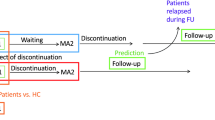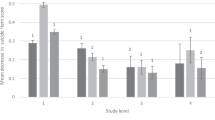Summary
A study was carried out involving 159 endogenous depressive inpatients treated with antidepressants. Using standardized rating instruments, a large set of potential predictor variables was tested. After cross-validation according to the split-half technique, only very few of these proved to be suitable as predictors for the main outcome criteria. These predictors included premorbid maladjustment, neurotic traits of premorbid personality, intensity of depressive-apathetic symptoms at admission, and the self-evaluated mood assessment score 3 weeks after commencement of treatment. This last criterion demonstrated the highest predictive value. Several predictors known from the literature could not be reproduced in this study.
Similar content being viewed by others
References
Ananth J (1978) Clinical prediction of antidepressant response. Int Pharmacopsychiatr 13:69–93
Angst J (1961) A clinical analysis of the effects of Tofranil in depression. Longitudinal and follow-up studies. Treatment of blood relations. Psychopharmakologia 2:381–407
Angst J (1965) Zur Prognose antidepressiver Behandlungen. Anglo-Germ Med Rev 2:733–751
Barthelmes H, Zerssen D v (1978) Das Münchner psychiatrische Informationssystem (PSYCHIS München). In: Reichertz P, Schwarz E (Hrsg) Informationssysteme in der medizinischen Versorgung, Ökologie der Systeme. Schattauer, Stuttgart, pp 138–145
Beckmann H (1978) Biochemische Grundlagen der engogenen Depression. Nervenarzt 49:557–568
Beckmann H (1981) Die medikamentöse Therapie der Depressionen. Nervenarzt 52:135–146
Bielski RJ, Friedel O (1976) Prediction of tricyclic antidepressant response. A critical review. Arch Gen Psychiatry 33:1479–1489
Brengelmann JC, Brengelmann L (1960) Deutsche Validierung von Fragebögen der Extraversion, neurotischen Tendenz und Rigidität. Z Exp Angew Psychol 7:291–331
Cording-Tömmel C, Zerssen D v (1982) Mianserin and Maprotilin as compared to amitriptyline in severe endogenous depression. A new methodological approach to the clinic evaluation of the efficacy of antidepressants. Pharmacopsychiatry 15:197–204
Deykin EY, DiMascio A (1972) Relationship of patient background characteristics to efficacy of pharmacotherapy in depression. J Nerv Ment Dis 155:209–215
Downing RW, Rickels K (1972) Predictors of amitriptyline response in outpatient depressives. J Nerv Ment Dis 154:248–263
Downing RW, Rickels K (1973) Predictors of response to amitriptyline and placebo in three outpatient treatment settings. J Nerv Ment Dis 156:109–129
Fähndrich E (1983) Clinical and biological parameters as predictors for antidepressant drug responses in depressed patients. Pharmacopsychiatry 16:179–185
Gaertner HJ, Kreuter F, Scharek G, Golfinopoulos G, Breyer-Pfaff U (1982) Zur klinischen Bedeutung einer biochemischen Differenzierung bei depressiven Erkrankungen. In: Beckmann H (Hrsg) Biologische Psychiatrie. Fortschritte psychiatrischer Forschung. Thieme, Stuttgart New York, pp 259–270
Giedke H, Axmann D, Gaertner HJ, Rein W, Rötzer-Zimmer FT (1986) Psychopathological predictors of antidepressant therapy response. Pharmacopsychatry 19:259–262
Gittelmann-Klein R, Klein D (1969) Premorbid asocial adjustment and prognosis in schizophrenia. J Psychiatr Res 7:35–53
Greden Jf, Gaerner R, King D, Grunhaus L, Carroll BJ, Kronfol Z (1983) Dexamethasone suppression test in antidepressant treatment of melancholia. The process of normalization and test-retest reproducibility. Arch Gen Psychiatry 40:493
Guy W (1976) Clinical Global Impressions (CGI). ECDEU Assessment, manual for psychopharmacology, rev edn. Rockville, Maryland, pp 217–222
Harris JG (1975) An abbreviated form of the Phillips Rating Scale of premorbid adjustment in schizophrenia. J Abnorm Psychol 84:129–137
Heimann H (1974) Therapy-resistant depressions: Symptoms and syndromes. Contributions to symptomatology and syndromes. Pharmakopsychiatr 7:139–144
Helmchen H (1974) Symptomatology of therapy-resistant depressions. Pharmakopsychiatr 7:145–155
Hollister LE, Overall JE, Johnson M, Penninton V, Katz G, Shelton J (1964) Controlled comparison of amitriptyline, imipramine and placebo in hospitalized depressed patients. J Nerv Ment Dis 139:370–375
Hordern A, Holt NF, Burt CG, Gordon WF (1963) Amitriptyline in depressive states. Phenomenology and prognostic considerations. Br J Psychiatry 109:815–825
Huber G, Gross G, Schüttler R (1979) Schizophrenie. Eine verlaufsund sozialpsychiatrische Langzeitstudie. Springer, Berlin Heidelberg New York
Kiloh LG, Ball JR, Garside RF (1962) Prognostic factors in treatment of depressive states with imipramine.Br Med J 2:1225–1227
Klerman GL, Cole JO (1965) Clinical pharmacology of imipramine and related antidepressant compounds. Pharmacol Rev 17:101–141
Kupfer DJ, Spiker DG (1981) Refractory depression: Prediction of non-response by clinical indicators. J Clin Psychiatry 42:307–311
Lehmann HE (1974) Therapy-resistant depressions — a clinical classification. Pharmakopsychiatry 7:156–163
Lesse S (1960) The evaluation of imipramine hydrochloride in the ambulatory treatment of depressed patients. J Neuropsychiatry 1:246–252
Levine J, Raskin A (1974) Predicting treatment responsiveness-resistivness in a population of depressed patients. Pharmakopsychiatry 7:217–222
Lorr M (1974) Assessing psychotic behavior by the IMPS. In: Pichot P, Olivier R (eds) Psychological measurement in psychopharmacology. Modem problems in pharmacopsychiatry. Karger, Basel
Möller HJ (1985) Kontrollierte Untersuchungen zum Wirkungsnachweis von Amitriptylin unter besonderer Berücksichtigung des Stellenwertes von Amitriptylin gegenüber den neuen Antidepressiva. Literaturübersicht und Analyse methodischer Probleme. In: Beckmann H, Sieberns (Hrsg) Das ärztliche Gespräch. 38. pmi Verlag, Frankfurt, pp 135–147
Möller HJ, Barthelmes H, Zerssen D von (1983) Forschungsmöglichkeiten auf der Grundlage einer routinemäßig durchgeführten Basis- und Befunddokumentation. Psychiatria Clin 16:1–16
Möller HJ, Kissling W, Bottermann P (1986) the dexamethasone suppression test in depressive and schizophrenic patients under controlled treatment conditions. Eur Arch Psychiatr Neurol Sci 235:263–268
Moore H, Kleining G (1960) Das soziale Selbstbild der Gesellschaftsschichten in Deutschland. Kölner Z Soziol Sozialpsychol 12:86
Morris JB, Beck AT (1974) The efficacy of antidepressant drugs. A review of research (1958–1972). Arch Gen Psychiatry 30:667–674
Paykel ES, Prusoff BA, Klerman GI, Haskell D, DiMascio A (1973) Clinical responses to amitriptyline among depressed women. J Nerv Ment Dis 156:149–165
Philipp M, Beck V, Glocke M, Metz K, Scherhag R, Schmidt R (1985) Vorhersagbarkeit des Therapieansprechens depressiver Patienten auf Doxepin. In: Philipp M (Hrsg) Grundlagen und Erfolgsvorhersage der ambulanten Therapie mit Antidepressiva. Springer, Berlin Heidelberg New York Tokyo, pp 29–45
Raskin A, Crook TH (1976) The endogenous-neurotic distinction as a predictor of response to antidepressant drugs. Psychol Med 6:59
Report to Medical Research Council by its Clinical Psychiatry Committee (1965) Clinical trial of the treatment of depressive illness. Br Med J 1:881
Sandifer MG, Wilson IC, Gambill JM (1965) The influence of case selection and dosage in an antidepressant drug trial. Br J Psychiatry 111:142–148
Strauss JS, Carpenter WT (1974) Prediction of outcome in schizophrenia. II: Relationship between predictor and outcome variables. Arch Gen Psychiatry 31:37–42
Wechsler D (1964) Die Messung der Intelligenz Erwachsener. Huber, Bern Stuttgart Wien
Woggon B (1980) Veränderungen der psychopathologischen Symptomatik während 20tägiger antidepressiver oder neuroleptischer Behandlung. Psychiatria Clin 13:150–164
Woggon B (1983) Prognose der Pharmakotherapie. Klinische Untersuchung zur Voraussagbarkeit des Kurzzeittherapierfolges von Neuroleptika und Antidepressiva. Forum der Psychiatrie 16, Enke, Stuttgart
Zerssen D von (1979) Klinisch-psychiatrische Selbstbeurteilungs-Fragebögen. In: Baumann U, Berbalk H, Seidenstücker G (Hrsg) Klinische Psychologie. Trends in Forschung und Praxis, Bd II. Huber, Bern
Zerssen D von (1980) Psychopathometrische Verfahrcn und ihre Anwendung in der Psychiatric. In: Peters (Hrsg) Psychologie des 20. Jahrhunderts, Bd X. Kindler, Zurich
Zerssen D von (1982) Personality and affective disorders. In: Paykel ES (ed) Handbook of affective disorders. Churchill Livingston, Edinburgh London Melbourne New York, pp 212–228
Zerssen D von (1986) Clinical self-rating scales (CSRS) of the Munich psychiatric information system (PSYCHIS München). In: Sartorius N, Ban TA (eds) Assessment of depression. Springer, Berlin Heidelberg New York, pp 270–303
Zerssen D von, Cording C (1978) The measurement of change in endogenous affective disorders. Arch Psychiatr Nervenkr 226:95–112
Zerssen D von, Koeller D-M (1976) Klinische Selbstbeurteilungs-Skalen (KSb-S) aus dem Münchener Psychiatrischen Informationssystem (PSYCHIS München). Manuale. a) Allgemeiner Teil; b) Beschwerden-Liste; c) Paranoid-Depressivitäts-Skala; d) Befindlichkeits-Skala. Beltz-Test, Weinheim
Author information
Authors and Affiliations
Rights and permissions
About this article
Cite this article
Möller, H.J., Fischer, G. & Zerssen, D.v. Prediction of therapeutic response in acute treatment with antidepressants. Eur Arch Psychiatr Neurol Sci 236, 349–357 (1987). https://doi.org/10.1007/BF00377424
Received:
Issue Date:
DOI: https://doi.org/10.1007/BF00377424




